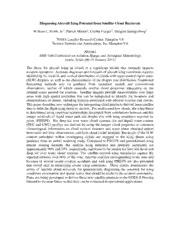
NASA Technical Reports Server (NTRS) 20160005965: Diagnosing Aircraft Icing Potential from Satellite Cloud Retrievals PDF
Preview NASA Technical Reports Server (NTRS) 20160005965: Diagnosing Aircraft Icing Potential from Satellite Cloud Retrievals
Diagnosing Aircraft Icing Potential from Satellite Cloud Retrievals William L. Smith, Jr.1, Patrick Minnis1, Cecilia Fleeger2, Douglas Spangenberg2 1NASA Langley Research Center, Hampton VA 2Science Systems and Applications, Inc, Hampton VA Abstract AMS 16th Conference on Aviation, Range, and Aerospace Meteorology Austin, Texas (06-10 January 2013) The threat for aircraft icing in clouds is a significant hazard that routinely impacts aviation operations. Accurate diagnoses and forecasts of aircraft icing conditions requires identifying the location and vertical distribution of clouds with super-cooled liquid water (SLW) droplets, as well as the characteristics of the droplet size distribution. Traditional forecasting methods rely on guidance from numerical models and conventional observations, neither of which currently resolve cloud properties adequately on the optimal scales needed for aviation. Satellite imagers provide measurements over large areas with high spatial resolution that can be interpreted to identify the locations and characteristics of clouds, including features associated with adverse weather and storms. This paper describes new techniques for interpreting cloud products derived from satellite data to infer the flight icing threat to aircraft. For unobscured low clouds, the icing threat is determined using empirical relationships developed from correlations between satellite imager retrievals of liquid water path and droplet size with icing conditions reported by pilots (PIREPS). For deep ice over water cloud systems, ice and liquid water content (IWC and LWC) profiles are derived by using the imager cloud properties to constrain climatological information on cloud vertical structure and water phase obtained apriori from radar and lidar observations, and from cloud model analyses. Retrievals of the SLW content embedded within overlapping clouds are mapped to the icing threat using guidance from an airfoil modeling study. Compared to PIREPS and ground-based icing remote sensing datasets, the satellite icing detection and intensity accuracies are approximately 90% and 70%, respectively, and found to be similar for both low level and deep ice over water cloud systems. The satellite-derived icing boundaries capture the reported altitudes over 90% of the time. Satellite analyses corresponding to the time and location of several recent aviation accidents and with icing PIREPS are also presented that reveal skill in identifying severe icing conditions. These results demonstrate the utility of satellite cloud retrievals for quantitatively diagnosing the potential for icing conditions on temporal and spatial scales that should be useful to the aviation community. Plans are being developed to deliver these new satellite products to the GOES-R Proving Ground in the near future so that they can be evaluated in operational applications.
